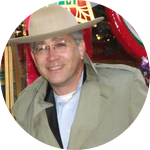About This Project
We are studying a population of moths in an unique oak ecosystem in a coastal barrier island environment to determine the relationship between the moth, its primary larval food plant, and the oak ecosystem it inhabits. This species, previously known only from Central Texas, has somehow evolved to live in a sand dominated coastal environment. Much of the known habitat will transition to Texas Parks & Wildlife management and our research will help in developing a sustainable land use plan.
Ask the Scientists
Join The DiscussionWhat is the context of this research?
We are studying the complete life cycle and specifically the egg laying behavior of Peiglers' Buck Moth. Our focus is on the unique adaptations to a coastal habitat. These moths are geographically isolated from the only other known population. Unlike many other species of Buck Moths these moths do not have to deal with snow or freezing temperatures but they do contend with fire and high temperatures. We have recently observed large brush fires in their habitat. We believe that the height at which the eggs have been laid keeps them relatively safe from these periodic brush fires.
The relationship between this Vulnerable Status moth species, fire and the coastal habitat has never been studied in depth - and needs to be profiled to help us protect and preserve the colony.
What is the significance of this project?
The moth species under investigation is currently listed as: "Conservation Status: Vulnerable (NatureServe)." The area that it inhabits is under a change in ownership. We believe that new studies on this unique ecosystem are needed to shape and guide the future plans for an amazing, unique coastal ecosystem. The Nature Conservancy & Texas Parks and Wildlife have purchased a huge tract of habitat and are now formulating their land use plans for the immediate future.
We will be able to offer insight to the supervising agencies. This new Conservation Area will encompass over 40% of the known coastal habitat for this species - so it represents an opportunity to provide guidance on how to best protect the colony while future land use and management plans are in the process of formulation.
What are the goals of the project?
1) Visit the location and survey recently burned areas for intact or recently hatched egg rings. Take additional measurements (height above ground and Branch Diameter) of any egg rings located.
2) We believe that the current larval population will be in a fourth or fifth Instar stage in mid-April and we need to look at the impact that the larva have on the environment - in particular on the larval food plant.
3) Confirm the identity of the oak(s) that is being used as the larval food plant and identify any other local plants that are used as the larva mature.
4) Further our knowledge of the ecosystem and all the biota that it contains by continuing the process of bio-cataloging using the iNaturalist application.
Budget
The budget for this project will be used to cover the costs for project members to travel to the Conservation area in Coastal Texas - for at least 5 additional field days in 2015 to complete our life cycle documentation. We plan to create CO1 DNA barcode studies of the moths, host plants, and any parasitoids that that we discover. Completing these research steps will allow us to complete the publications that we have in process. We need to procure field collection and measurement equipment like Vernier calipers, light traps for nocturnal moths, and materials to construct rearing cages for caterpillars. The DNA profiles (using DNA barcodes) of all known host plants, the moths themselves and any parasitoids that are discovered will help to confirm the identity of species involved in the life cycle. We plan to create Herbarium sheets of all the trees and significant plants in the habitat.
We need your help to ensure protection for a keystone moth species in a very unique coastal ecosystem.
Endorsed by
Meet the Team
Team Bio
Research Associate in Lepidoptera
Webmaster and Enabling Technology Manager
I am studying Butterflies and Moths with the multi-disciplinary assistance of Botanists, Geologists, Biogeographers and my fellow Research Associates. My goal is to help the ETNHC succeed at its mission of bringing interested scientists to interesting Texas habitat to begin to document undiscovered science!
I am also a Board Member & Secretary for The Natural History Trust for Eastern and Northern Texas. This new Natural History organization will be a big part of my public contributions going forward.
I am a Lifetime member of the International Congress of Entomology and Zoology Studies - AICEZS. This innovative publication will be our primary publishing partner for all scientific publications.
See: http://www.entomoljournal.com/about.html
Specialties
Curation and collection of Lepidoptera
Larval propogation of Saturniidae lavae
Public Speaking and Presentations
Public Night Moth Lighting shows
bob.nuelle.jr@gmail.com
Robert J. "Bob" Nuelle, Jr.
I have been studying Lepidoptera (Butterflies and Moths) since Grade School (many years ago!) and my enthusiasm and thirst for knowledge continues unabated.
I am currently involved in 5 long term projects - 4 area focused projects (Calhoun County, TX - Wood County, TX , Harris/Montgomery County, Tx & San Antonio, TX Regional Studies) and 1 species specific project (Hemilueca peigleri). I post my sightings on iNaturalist -- SO SHOULD YOU!!! -- http://www.inaturalist.org
Additional Information
Lab Notes:
Be sure to check our lab notes too - lots of good background material there.
Attend a Briefing:
This is a link to a pre-recorded briefing about the project and its goals. It is approximately 18 minutes long and describes in depth the overall project and all the science that is happening.
http://tinyurl.com/research-briefing
Photography:
1) Photos of the Target Species Ova Rings: LINK
2) Photos of the Caterpillars: LINK
3) Photos of the Adult Moth: LINK
We are focused on promoting the Citizen Science movement. We intend to highlight the efforts and amazing contributions of citizen scientists through iNaturalist.org. We are motivated by these projects and you can see our efforts here: http://www.inaturalist.org -- member name "rjnjr".
Our iNaturalist Project:
The Powderhorn Ranch Conservation Area
Project Backers
- 20Backers
- 103%Funded
- $2,079Total Donations
- $69.45Average Donation

